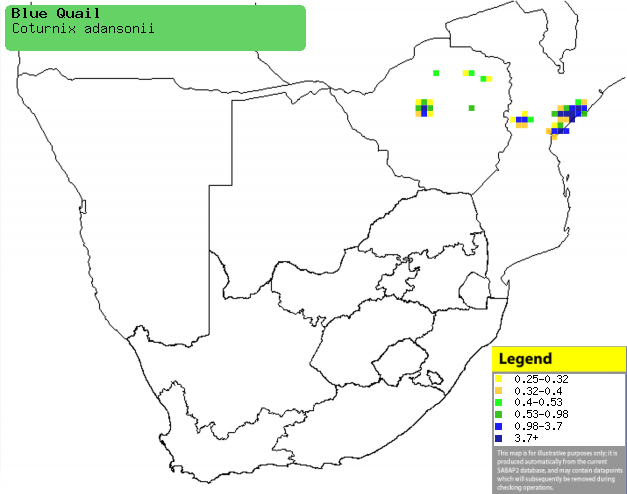|
Coturnix adansonii (Blue
quail)
Bloukwartel [Afrikaans]; Huta (generic name for quail)
[Shona]; Xindogo, Xitshatshana [Tsonga]; Caille bleue [French]; Zwergwachtel
[German]; Codorniz-azul [Portuguese]
Life
> Eukaryotes >
Opisthokonta
> Metazoa (animals) >
Bilateria >
Deuterostomia > Chordata >
Craniata > Vertebrata (vertebrates) > Gnathostomata (jawed
vertebrates) > Teleostomi (teleost fish) > Osteichthyes (bony fish) > Class:
Sarcopterygii (lobe-finned
fish) > Stegocephalia (terrestrial
vertebrates) > Tetrapoda
(four-legged vertebrates) > Reptiliomorpha > Amniota >
Reptilia (reptiles) >
Romeriida > Diapsida > Archosauromorpha > Archosauria >
Dinosauria
(dinosaurs) > Saurischia > Theropoda (bipedal predatory dinosaurs) >
Coelurosauria > Maniraptora > Aves
(birds) > Order: Galliformes >
Family: Phasianidae
Identification
The male is a colourful, attractively patterned quail with
black and white throat and unlike other local quails, does not have a white
eyebrow stripe. It also has distinctive slate blue colouring on the breast. In flight
the rufous on the upper wing coverts is distinctive. The female and juvenile can
be distinguished from other quails by the barring on breast and flanks.
The Blue quail is the smallest of the quails in southern
Africa, weighing only 43-47 g (range of average weights for other quail in the
region is 70 to 100 g; the average weights of
buttonquails, which fall in a different order altogether, range from 35-60
g).
The Blue quail is considered to be very similar to the
Blue-breasted quail Coturnix chinensis, which occurs in Asia, and in fact
with further research they may turn out to be assessed as the same species.
Blue quail are difficult to see as they are not only highly
localised within southern Africa but within their prime habitat they usually
remain under cover and are difficult to flush. However, they evidently come into
the open to feed in the early morning, shortly after dawn.
Distribution and habitat
Most often occurs in moist grassy habitats within woodland,
often along the border of wetlands. Its distribution ranges through moist
woodlands of sub-Saharan Africa. Within southern Africa it is found mainly on
the Mashonaland plateau in Zimbabwe and in parts of Mozambique. There are also
isolated records mainly from KwaZulu-Natal and the Eastern Cape. It is
considered to be a summer breeding visitor to southern Africa, its migration
patterns beings strongly influenced by rainfall. After breeding it migrates to
areas of Africa north of southern Africa but little is known about the nature of
these migrations other than that they are undertaken at night (birds are
attracted to lights at night).
|
 |
|
Distribution of Blue quail in southern Africa,
based on statistical smoothing of the records from first SA Bird Atlas
Project (©
Animal Demography unit, University of
Cape Town; smoothing by Birgit Erni and Francesca Little). Colours range
from dark blue (most common) through to yellow (least common). |
Call
Predators and parasites
Little information available. Nests and young birds
would be particularly vulnerable to mammalian predators.
Food
The following food items have been recorded
in its diet:
- Seeds of grasses and weeds
- Green plant material
- Insects, including
termites
- Molluscs
Breeding
A clutch of 3-9 eggs is laid in the summer rainy
season, from December to April. The nest is a scrape in the ground among
grasses or sedges and sometimes has a lining of grass stems. Incubation last
about 16 days and the limited information available indicates that it is
undertaken by the female although the presence of a brood patch in the male
suggests that he may also incubate. Both male and female care for the young,
which become independent at about four weeks when they have become capable
in flight. Ambient temperatures of less than 20șC can cause death of chicks
in their first 2-3 weeks.
References
-
Hockey PAR, Dean WRJ and Ryan PG (eds) 2005. Roberts
- Birds of southern Africa, VIIth ed. The Trustees of the John Voelcker
Bird Book Fund, Cape Town.
-
Sinclair, I, Hockey, P. and Tarboton, W. 2002. Sasol
Birds of Southern Africa. 3rd edition. Struik, Cape Town.
|
